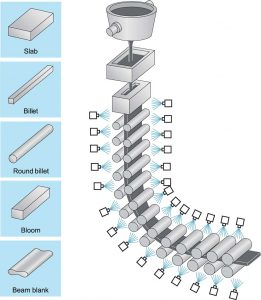June 17, 2019
What’s important with secondary cooling for CCM (Continuous Casting Machine)?

How can we help steelmaking plant during the secondary cooling process for CMM?
Nowadays, the demand for steel is getting more and more specific (like high tensile strength steel, advanced high-strength steel, etc.). The market worldwide is split between emerging economies where the demand and production are growing, the US with tariffs and their uncertain trade environment, and Europe with a slower production growth.
Therefore, it is becoming crucial for steelmaking plant to stay competitive, control / reduce their cost, and increase productivity to fulfill the growing demand.
When it comes to control the quality of the cast steel product (end result), the secondary cooling for continuous casting machines is the most crucial step of the process.
What is important during the secondary cooling process?
The process of secondary cooling for continuous casting machines includes 2 different cooling performance:
- Cooling of the steel itself (slab, bloom, billet, beam blank);
- Cooling of the rolls of casting machine.
The cooling parameters rely on various conditions:
- the different steel grades to be cast;
- the different steel shape (slab, bloom, billet, beam blank) as the cooling performance needs to be adjusted to each shape (spray coverage);
- the spray coverage, which will impact the spray nozzle alignment;
- the condition of the existing machines or new machines;
- the casting speed;
- the cooling control systems;
- the maintenance flexibility;
- the operational flexibility.
1. Cooling of the steel itself
The quality of the steel depend on the solidification process during the secondary cooling. It is important to control the cooling of the solidifying steel to avoid:
- Under and/or uneven cooling = bulging, breakout
- Over cooling = formation of surface cracks
An improper cooling would result in creating weak spots, visible cracks on the steel and uneven surface of the steel.
Therefore, more efficient and reliable spray cooling is required to:
- Generate an uniform cooling;
- Reduce surface cracking;
- Maintain a satisfactory surface temperature profile;
- Minimize or eliminate surface and internal defects in the cast product (no weak spot acceptable for prime grade steel);
- Control water consumption.
2. Cooling of the rolls of casting machine
While the steel is cooled down during casting, it is transported on rolls to which heat is transferred. Thus, removing the heat from the rolls is also needed to generate an optimum solidification of the steel.
If the rolls are simultaneously cooled down evenly, it has an effect to generate the ideal solidification conditions. In some case, it can help to achieve full solidification.
The goal remains always the same: to ensure an optimal and uniform cooling. That is why it is important for spray nozzles to be able to control the spray distribution and spray impact.

How to maintain optimum casting parameters?
Because it is important to always have an even cooling to minimize the appearance of cracks, but the production characteristics constantly change depending on the cast product, steelmaking plant need to be flexible.
In order to benefit of an operational and maintenance flexibility, you need to control the cooling performance by just adjusting the casting parameters.
You can maintain optimum casting parameters by controlling the spray impact and nozzle arrangements to cover the needed cooling area.
The pressure, spray capacity (flow rate) and spray pattern of the nozzles determine the cooling impact / intensity and the spray distribution on the steel surface.
What we offer?
- Customized solution per plant depending on steel grade, shape, existing or new casting machines;
- Consulting service for cooling performance efficiency through cooling trial experiments, to provide the optimum nozzles and layout.
What’s your benefits?
- Increase operational flexibility
- Possibility to product different steel with one series of nozzle (slab, bloom, billet, beam blank)
- Increased steel quality
- Higher productivity and optimum quality of continuous casting process thanks to cooling performance
- Saving energy while reducing air and water consumption while still benefit of a strong cooling performance
- Maintenance flexibility
- Reduced maintenance time and cost

We will be showcasing our solutions for the secondary cooling process and other process for iron and steelmaking during the METEC exihbition in June in Düssedorf.
Come and visit us at our booth Hall 3 C02 to discuss with our sales engineers!
